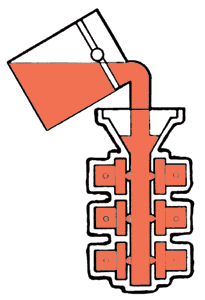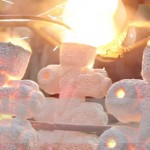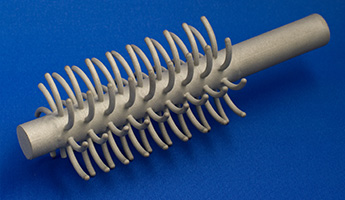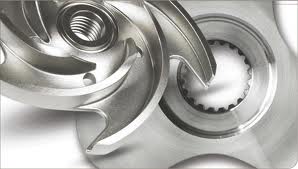What makes Investment Casting the BEST way to cast metal?
In it’s simplest form, investment casting can be thought of as the melting and flowing of any of todays common engineering metals and alloys into molds of virtually any net shape, to produce a near net shape component once cooled. Comparing this to the widely accepted practice of machining components from solid raw stock, where material is REMOVED to get to the net end shape, and all of the problems associated with that, this is a very simple way to visualize just how much sense it makes to consider investment castings for cost effective manufacturing of many components. 
Niagara Investment Castings’s investment castings offer many advantages to the end user, designer, or manufacturer, by utilizing this single process to produce components, often originally conceived to be manufactured in ways that were either too costly or too restrictive in terms of design elements. These investment castings take on a unique characteristic unattainable by other processes, due primarily to our using die injected wax shapes as patterns. This allows us to obtain the detail and accuracy of components made by injection molding, usually reserved for low melting point metals, but in fact made from high melting point metals and alloys such as steel and stainless steel. This is because of the unique formation of a seamless ceramic shell built around the precision wax shapes. The ceramic shell holds the shape of these wax geometries at extremely high temperatures while the molten metal, poured into the shells, solidifies into your castings. Due to these inherent, precise, and unlimited geometries possible with the investment casting process, the investment casting process provides the following benefits:
ACCURACY
Using investment castings produces components that are best described as near-net-shape, in other words, components that require little or no further processing. The process is capable of producing precise detail and dimensional accuracy of approximately +/-0.005” per inch of dimension in castings of up to 200 pounds or just a few ounces.
 WIDE CHOICE OF ALLOYS
WIDE CHOICE OF ALLOYS
Hundreds of different alloys can be cast using the investment casting process, in most commonly used base metals such as steels, stainless steels, copper, nickel, irons, cobalt, and more. A key advantage often overlooked is that since finish machining can be minimized or eliminated, alloy selection can be upgraded to stronger metals, which are typically harder to machine, resulting in better performance of the end product. Niagara Investment Castings casts most of the common engineering metals used by a wide range of industries, as well as many specialized metals for demanding applications.
AFFORDABLE TOOLING
In all other processes, tooling is a significant cost factor. However, investment casting tooling is produced from easily machined aluminum alloy, but because it is only receiving wax, it has an extremely long life. Niagara Investment Castings works with our clients to assist with tooling requirements, and looks after all tool manufacturing, and storage of the completed tooling. Costs for these wax tools is substantially less than that of die casting or forging dies, and many times dies can be made as multiple cavities as well as semi or full automation to reduce casting costs even more, yielding exceptionally high return on the investment of the tool.
REDUCE PRODUCTION COSTS, INCREASE PROFITS
 The most common applications for investment castings are in situations where costly finishing operations can be reduced, or even eliminated, for existing metal components. This is due to the accuracy of detail and dimensions attainable with investment casting, and superior aesthetics. Today, more and more manufacturers are turning to designing their new components as investment castings, since several parts can be made as one casting, reducing handling, assembly, welding, and inspection costs.
The most common applications for investment castings are in situations where costly finishing operations can be reduced, or even eliminated, for existing metal components. This is due to the accuracy of detail and dimensions attainable with investment casting, and superior aesthetics. Today, more and more manufacturers are turning to designing their new components as investment castings, since several parts can be made as one casting, reducing handling, assembly, welding, and inspection costs.
COMPONENT DETAILS
Investment casting is a designer’s dream. Complex shapes, both externally and internally are possible through the use of tool design, soluable wax coring, or ceramic coring. Internal configurations not possible with most other manufacturing processes can be provided by Niagara Investment Castings through the use of investment castings. Externally, draft-free walls, splines, holes, bosses, lettering, serrations and even some threads can be easily cast as well.
MINIMAL METAL LOSSES
Using investment castings produces components that require little machining, and therefore there are significant reductions in lost metal to chips and shavings. This is especially valuable when working with materials such as stainless steels, nickel alloys, and cobalt alloys, which are not only costly, but difficult to machine.
CONSISTENCY OF COMPONENTS
Since cast components are produced by using wax patterns from a single tool, dimensional accuracy is the same from part to part, year after year. When design changes are required, it is usually possible to alter existing tooling at a relatively minor cost.
part to part, year after year. When design changes are required, it is usually possible to alter existing tooling at a relatively minor cost.
SPEED OF CONCEPT TO CASTING
From design to completion, investment castings can usually be supplied in under 12 weeks. If prototypes are of interest, we are pleased to offer in-house Rapid Prototyping services utilizing our unique 3D wax printing system to produce wax patterns in only a matter of days from receipt of your drawing files, with castings available usually less than 3 weeks later.
